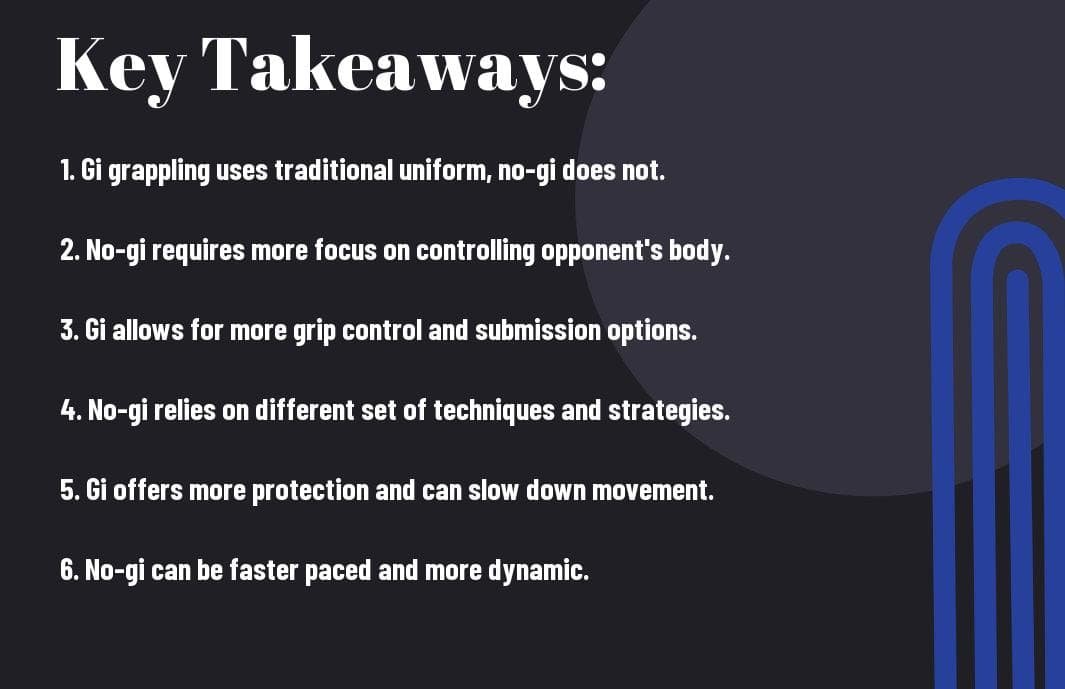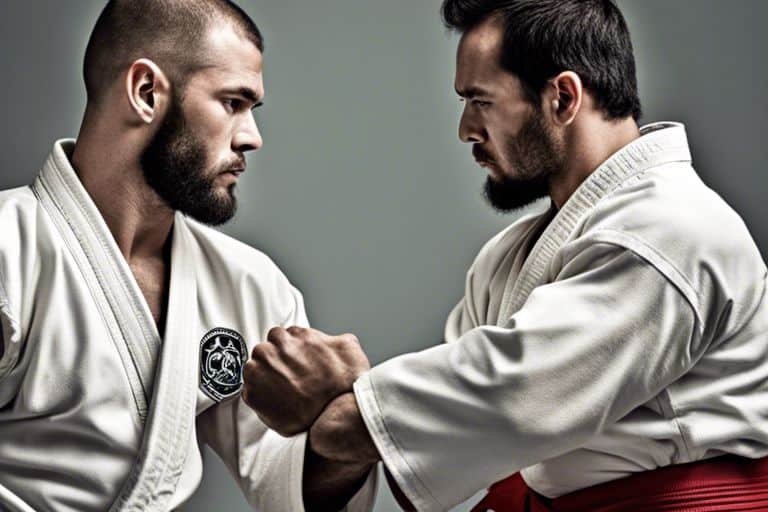Are you confused about the disparities between Gi and No-Gi grappling? Many individuals in the martial arts community are. Understanding the differences between the two styles is crucial as it can affect your performance, strategy, and overall approach to grappling. Whether you’re new to the sport or a seasoned practitioner, this blog post will provide you with a comprehensive overview of the variances between Gi and No-Gi grappling, allowing you to make more informed decisions about your training and competition.
Key Takeaways:
- Attire: The main difference between gi and no-gi grappling is the attire worn during the practice. Gi grappling involves wearing a traditional martial arts uniform, while no-gi grappling involves wearing shorts and a rash guard.
- Grip Techniques: In gi grappling, practitioners can use the material of the uniform to secure grips and control their opponents. In no-gi grappling, the absence of a gi requires practitioners to rely on different grip techniques such as wrist control and underhooks.
- Speed and Fluidity: No-gi grappling is often characterised by its faster pace and emphasis on movement and transitions, while gi grappling allows for a more methodical and strategic approach due to the ability to use the gi for control and leverage.
- Submission Opportunities: Each style of grappling offers unique submission opportunities based on the attire worn. Gi grappling allows for chokes and joint locks using the material of the gi, while no-gi grappling may rely more on techniques such as guillotines and leg locks.
- Training Focus: Practitioners may choose to focus on either gi or no-gi grappling depending on their preferences and goals. Some may prefer the technical aspects of gi grappling, while others may enjoy the fast-paced nature of no-gi grappling.

The Gi in Grappling
When it comes to grappling, the gi plays a significant role in shaping the sport. It is important to understand the differences between gi and no-gi grappling so that you can make an informed decision about which style is right for you. For a detailed look at the differences between gi and no-gi jiu-jitsu, check out No-Gi vs. Gi Jiu Jitsu: Differences & Which To Choose.
Definition and Historical Context
Gi grappling, also known as traditional Brazilian Jiu-Jitsu (BJJ), involves the use of a gi – a traditional martial arts uniform resembling a judo uniform. This style of grappling has its roots in Japanese jiu-jitsu and judo, and was further developed by the Gracie family in Brazil. The gi, consisting of a jacket and pants, is an essential part of this grappling style, with techniques and strategies tailored to leverage the use of the uniform for control and submissions.
Key Characteristics of Gi Grappling
In gi grappling, the gi itself becomes an integral tool in your game. The lapels and sleeves of the gi can be used to control your opponent, set up submissions, and create leverage. Gripping the gi fabric provides a tactical advantage, allowing you to immobilise your opponent and execute various techniques. The use of the gi introduces a high level of technicality and strategic thinking into your grappling game. Additionally, the gi can be both a defensive and offensive tool, offering various ways to trap and control your opponent while giving them fewer opportunities to escape.
No-Gi Grappling Explained
When it comes to the world of grappling, the term “no-gi” refers to a style of combat that focuses on techniques and strategies that do not rely on the use of a traditional martial arts uniform, or gi. This means that the emphasis is placed on controlling and manipulating your opponent’s body rather than using the grips and handles provided by a gi. No-gi grappling is a fast-paced, dynamic form of combat that requires a high level of athleticism and adaptability.
Fundamental Aspects of No-Gi
One of the fundamental aspects of no-gi grappling is the emphasis on close body control and maintaining a strong base. Without the grips and handles provided by a gi, you are required to rely on tight body control and strong positioning to execute your techniques effectively. This means that your balance and leverage become even more important, as they are key to controlling your opponent and creating opportunities for submission.
The Influence of No-Gi on Modern Martial Arts
No-gi grappling has had a significant influence on modern martial arts, particularly in the realm of mixed martial arts (MMA). The fast-paced, dynamic nature of no-gi grappling has proven to be an essential component of MMA training, as it provides practitioners with the ability to seamlessly transition between striking and grappling. The emphasis on athleticism and adaptability in no-gi grappling has also helped to shape the evolution of modern martial arts, making it an indispensable part of any well-rounded martial arts practice.
Comparing Gi and No-Gi Techniques
When it comes to the differences between gi and no-gi grappling techniques, there are several factors to consider. If you want to delve deeper into this topic, you can refer to this Gi Vs. No-Gi BJJ: Which Is Better For You? article. Here’s a breakdown of the key differences:
| Gi Grappling | No-Gi Grappling |
| Relies on grips and fabric manipulation | Focuses on underhooks and overhooks |
| More emphasis on controlling your opponent’s gi | Requires more reliance on body control and athleticism |
| Many submissions involve using the gi for chokes and joint locks | Submissions focus on using leverage and body positioning |
Impact of Attire on Grappling Techniques
The type of attire worn during gi and no-gi grappling has a significant impact on the techniques used. In gi grappling, the presence of the traditional uniform allows for the use of grips and fabric manipulation to control your opponent. This enables you to set up various holds and submissions with the help of the gi. On the other hand, in no-gi grappling, the absence of the gi eliminates these options, requiring you to rely more on body control, positioning, and athleticism to execute your techniques.
Strategy and Adaptation in Gi versus No-Gi
When it comes to strategy and adaptation, the differences between gi and no-gi grappling are crucial. In gi grappling, you must become proficient at using the gi to your advantage, including setting up sweeps, controlling your opponent, and executing submissions using the gi. On the other hand, in no-gi grappling, you need to adapt your strategy to focus on controlling your opponent using body positioning and leverage, without the aid of the gi. This requires a different approach and set of techniques to be effective in your grappling game.
Training Considerations and Gear
When it comes to training for gi and no-gi grappling, there are some key differences to consider. Not only do the techniques and strategies vary, but the gear and apparel you use will also differ depending on the type of grappling you are focusing on. In this chapter, we will discuss the training considerations and gear for both gi and no-gi grappling to help you understand the essential elements for each.
Preparing for Gi Grappling Sessions
When preparing for gi grappling sessions, it is essential to ensure that you have the right gear and apparel. The most important piece of equipment for gi grappling is, of course, the gi itself. This traditional uniform consists of a jacket, pants, and belt, all of which are designed to provide ample grip for controlling and executing techniques on your opponents. Additionally, you may want to invest in a rash guard to wear underneath your gi jacket to prevent friction and irritation on your skin. As for footwear, a pair of well-fitted wrestling or jiu-jitsu shoes can offer extra grip and stability on the mat, keeping you grounded during training and competitions.
Essential No-Gi Gear and Apparel
When it comes to no-gi grappling, the gear and apparel are streamlined compared to gi grappling. You will typically wear form-fitting athletic wear, such as compression shorts and rash guards, to minimize friction and provide some protection from skin abrasions. The lack of a gi jacket and the reduced gripping surface means that your techniques will need to adapt to the absence of traditional grips. In addition to the appropriate clothing, no-gi grappling may also require the use of grappling spats or tight-fitting shorts to avoid exposing skin and to ensure a secure fit that won’t interfere with your movements. One significant advantage of no-gi grappling gear is that it tends to be lighter and more breathable, allowing for more freedom of movement when engaging in intense sparring sessions.
Conclusion
Following this exploration of the differences between gi and no-gi grappling, you now have a better understanding of the unique aspects of each style. Whether it’s the use of grips and submissions in gi grappling or the emphasis on speed and agility in no-gi grappling, both styles offer valuable opportunities for learning and growth. By being aware of these differences, you can make informed choices about which style best suits your preferences and goals. Regardless of your choice, both gi and no-gi grappling provide valuable opportunities for improving your technique and overall skillset in the world of martial arts.
FAQ
Q: What is the difference between Gi and No-Gi grappling?
A: The main difference between Gi and No-Gi grappling lies in the attire. Gi grappling involves the use of a traditional martial arts uniform known as a Gi, whereas No-Gi grappling is conducted without the use of a Gi, with practitioners wearing rash guards and shorts instead.
Q: What are some of the key differences in techniques between Gi and No-Gi grappling?
A: Gi grappling often involves the use of grips on the Gi fabric, leading to a different set of techniques such as collar chokes and sleeve control. No-Gi grappling, on the other hand, focuses more on controlling the opponent’s body with underhooks, overhooks, and body positioning due to the absence of Gi grips.
Q: How does the pace of the match differ between Gi and No-Gi grappling?
A: Generally, No-Gi grappling tends to be faster-paced compared to Gi grappling. The absence of Gi grips leads to more reliance on movement and agility, resulting in a quicker exchange of techniques and positions.
Q: Are there any specific rules that differ between Gi and No-Gi grappling competitions?
A: While the core rules of grappling remain the same, certain competitions may have specific regulations for Gi and No-Gi matches. For example, Gi competitions may have rules regarding allowable Gi grips and uniform specifications, whereas No-Gi competitions focus on prohibiting certain grips that are specific to Gi grappling.
Q: What are the benefits of training in both Gi and No-Gi grappling?
A: Training in both Gi and No-Gi grappling allows practitioners to develop a well-rounded skill set. Gi training enhances grip strength, technical precision, and strategic thinking, while No-Gi training improves speed, agility, and adaptability to different grappling styles.
Q: Do the strategies and tactics differ between Gi and No-Gi grappling?
A: Yes, the strategies and tactics used in Gi and No-Gi grappling can differ significantly. Gi grappling often involves setting up attacks using the leverage provided by the Gi fabric, while No-Gi grappling focuses more on controlling the opponent’s body to secure submissions and advance positions.
Q: Are there specific uniform requirements for Gi and No-Gi grappling training and competitions?
A: Yes, Gi grappling requires the use of a traditional Gi uniform consisting of a jacket and pants, while No-Gi grappling permits the use of rash guards, shorts, and spats. It’s important to adhere to the specific uniform requirements set by training facilities and competition organisers for each style of grappling.



